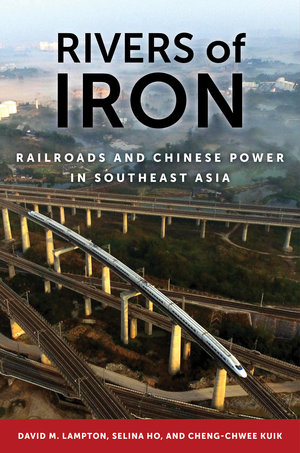By David M. Lampton, co-author of Rivers of Iron: Railroads and Chinese Power in Southeast Asia
This guest post is part of our #AAS2021 conference series. Visit our virtual exhibit to learn more.
With its global-scale Belt and Road Initiative (BRI) and railway-building exertions in Southeast Asia, China is now arguably the world’s largest builder and proponent of big infrastructure. Why is this so?
As a frequent traveler between Shanghai and Nanjing over the last two decades, I witnessed the railroad travel time drop from about four hours to a bit over one hour in only a few years. Higher-speed rail lines were built by highly choreographed construction brigades working simultaneously, the result being that ever-faster lines appeared almost magically. During our research team’s 2017 fieldwork in Laos for our new book, Rivers of Iron: Railroads and Chinese Power in Southeast Asia, we observed Chinese construction brigades carving through mountainous karst and jungle terrain, with red clay gumming up everything. Six PRC construction brigades were working simultaneously on a rail line from China to the Thai border near Vientiane. This northern part of the “Central Line” is scheduled for completion in December 2021. Over 60 percent of the mileage traverses bridges and goes through tunnels. Working conditions are dangerous and the area near Vietnam is pockmarked with unexploded ordnance, a tragic residue from America’s “secret war” in Laos.
All this raises many questions. How did China create a competitive high-speed rail industry so rapidly? What will be the economic and strategic effects of these endeavors? Does it have anything to do with China’s political culture, institutional structure, and deeply engrained developmental perspective? And, is China now exploiting, and exporting, a national comparative advantage honed for over two millennia?
In our team’s research, we found that a few of the key reasons that China looms so large in international infrastructure projects are the availability of “cheap capital,” excess capacity in steel and cement, the ability to focus resources on champion industries and projects, and a surging tide of PRC engineering and other talent. But the political culture and the origins of the Chinese state also play significant roles. This is a people who have said to themselves for hundreds of years, “If you want to get rich, build a road!”
This tradition of big infrastructure in part comes from a public goods-providing ethos embedded in the Chinese state, of which infrastructure is a major component.
David M. Lampton
China’s ability to conceive, execute, and manage enormous projects goes back to the Grand Canal (468 BC), the Dujiangyan Irrigation Works on the Sichuan Plain (256 BC), and the Great Wall built over centuries. In the PRC era, the Three Gorges Dam and the South to North Water Diversion project carry on this tradition, not to mention the ongoing construction of China’s impressive domestic high-speed rail network and now its lunar and Mars programs. When it comes to infrastructure, China does not think small.
This tradition of big infrastructure in part comes from a public goods-providing ethos embedded in the Chinese state, of which infrastructure is a major component. Chinese agriculture, based as it was on rice, had functional requirements: level paddies graded to exacting tolerances, huge water conservancy undertakings (dikes, dams, retention areas, and irrigation systems), and reliable transport and grain storage systems. Creating, managing, and physically defending such an interdependent system required huge volumes of conscripted labor; an efficient taxation system to assure adequate revenues; a powerful and skilled bureaucracy; and, a large military to protect against the predations of hostile forces. Chinese political culture and state institutions reflect these imperatives.
This brings us to a core issue raised in Rivers of Iron. How should outside powers view today’s outward infrastructure thrust by Beijing? Do competitive powers need to get into the infrastructure game?
The World Bank is again placing greater emphasis on infrastructure, having previously been reticent because such projects have controversial impacts. For its part, through the BUILD Act (2018) and other measures, the U.S. is placing greater emphasis on infrastructure in Asia and elsewhere. It also is working with its allies in ensuring quality infrastructure. The European Union announced the EU-Asia Connectivity Strategy in 2018. Japan, which has long played an active role in Asia’s infrastructure, launched its Partnership for Quality Infrastructure in 2015.
Looking ahead, we should ask how the United States and like-minded, market-based economies can get more involved in this development process and geo-economic competition, given that their political and economic systems are more pluralized and less centralized than is the PRC’s. Convincing democratic polities to invest in projects abroad is difficult when their own domestic infrastructure is in disrepair. And yet, failure to participate will result in an Asia the economic center of which is the PRC.

